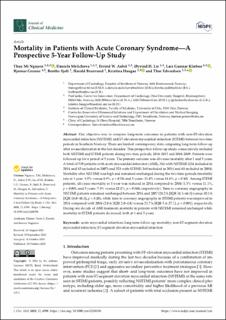| dc.contributor.author | Nguyen, Thuy Mi | |
| dc.contributor.author | Melichova, Daniela | |
| dc.contributor.author | Aabel, Eivind Westrum | |
| dc.contributor.author | Lie, Øyvind Haugen | |
| dc.contributor.author | Klæboe, Lars Gunnar | |
| dc.contributor.author | Grenne, Bjørnar Leangen | |
| dc.contributor.author | Sjøli, Benthe | |
| dc.contributor.author | Brunvand, Harald | |
| dc.contributor.author | Haugaa, Kristina Ingrid Helena Hermann | |
| dc.contributor.author | Edvardsen, Thor | |
| dc.date.accessioned | 2023-11-17T08:57:56Z | |
| dc.date.available | 2023-11-17T08:57:56Z | |
| dc.date.created | 2023-11-10T13:16:02Z | |
| dc.date.issued | 2023 | |
| dc.identifier.citation | Journal of Clinical Medicine. 2023, 12 (20), . | en_US |
| dc.identifier.issn | 2077-0383 | |
| dc.identifier.uri | https://hdl.handle.net/11250/3103128 | |
| dc.description.abstract | Our objective was to compare long-term outcomes in patients with non-ST-elevation myocardial infarction (NSTEMI) and ST-elevation myocardial infarction (STEMI) between two time periods in Southern Norway. There are limited contemporary data comparing long-term follow-up after revascularization in the last decades. This prospective follow-up study consecutively included both NSTEMI and STEMI patients during two time periods, 2014–2015 and 2004–2009. Patients were followed up for a period of 5 years. The primary outcome was all-cause mortality after 1 and 5 years. A total of 539 patients with acute myocardial infarction (AMI), 316 with NSTEMI (234 included in 2014 and 82 included in 2007) and 223 with STEMI (160 included in 2014 and 63 included in 2004). Mortality after NSTEMI was high and remained unchanged during the two time periods (mortality rate at 1 year: 3.5% versus 4.9%, p = 0.50; and 5 years: 11.4% versus 14.6%, p = 0.40). Among STEMI patients, all-cause mortality at 1 year was reduced in 2014 compared to 2004 (1.3% versus 11.1%, p < 0.001; and 5 years: 7.0% versus 22.2%, p = 0.004, respectively). Time to coronary angiography in NSTEMI patients remained unchanged between 2014 and 2007 (28.2 h [IQR 18.1–46.3] versus 30.3 h [IQR 18.0–48.3], p = 0.20), while time to coronary angiography in STEMI patients was improved in 2014 compared with 2004 (2.8 h [IQR 2.0–4.8] versus 21.7 h [IQR 5.4–27.1], p < 0.001), respectively. During one decade of AMI treatment, mortality in patients with NSTEMI remained unchanged while mortality in STEMI patients decreased, both at 1 and 5 years. | en_US |
| dc.language.iso | eng | en_US |
| dc.publisher | MDPI | en_US |
| dc.rights | Navngivelse 4.0 Internasjonal | * |
| dc.rights.uri | http://creativecommons.org/licenses/by/4.0/deed.no | * |
| dc.title | Mortality in Patients with Acute Coronary Syndrome—A Prospective 5-Year Follow-Up Study | en_US |
| dc.title.alternative | Mortality in Patients with Acute Coronary Syndrome—A Prospective 5-Year Follow-Up Study | en_US |
| dc.type | Peer reviewed | en_US |
| dc.type | Journal article | en_US |
| dc.description.version | publishedVersion | en_US |
| dc.source.pagenumber | 0 | en_US |
| dc.source.volume | 12 | en_US |
| dc.source.journal | Journal of Clinical Medicine | en_US |
| dc.source.issue | 20 | en_US |
| dc.identifier.doi | 10.3390/jcm12206598 | |
| dc.identifier.cristin | 2195071 | |
| dc.relation.project | Norges forskningsråd: 309762 | en_US |
| cristin.ispublished | true | |
| cristin.fulltext | original | |
| cristin.qualitycode | 1 | |

